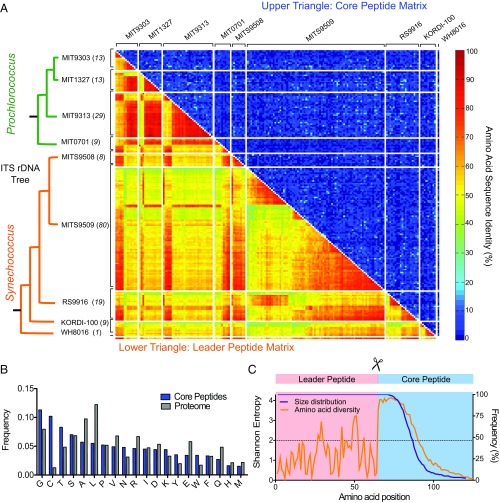Fig. 2.
Genetic variation of prochlorosin precursor peptides. (A) Percentage of amino acid identity for each pairwise comparison in a multiple sequence alignment of the leader peptide region (Lower triangle) and the core peptide region (Upper triangle) of the 181 prochlorosin precursor peptides found in nine nonclonal lanthipeptide-encoding strains of Prochlorococcus and Synechococcus. The precursor peptides in the matrix were grouped first by the phylogenetic relationship of the strain of origin (based on ITS ribosomal DNA, at left) and then by the intragenome amino acid identity of their leader peptide region. Only one pair of prochlorosins originating in MIT9313 and MIT1327 share 100% identity in their core region; their leader peptide region is 98% identical. (B) Amino acid composition of the prochlorosin core peptides (weighted average of frequency) found in Prochlorococcus and Synechococcus genomes compared with the general proteome composition of these strains. Gly, a flexible small amino acid, along with amino acids necessary for the formation of ring structures (Cys, Ser, and Thr), are the most frequent residues in the prochlorosin core peptides; all but Ser are found at a higher frequency in prochlorosin core peptides than in the general proteome. (C) Size distribution (purple line, right y axis) and amino acid diversity by Shannon entropy at each position (orange line, left y axis) of prochlorosin precursor peptides. Positions within the leader peptide region correspond to the consensus of the multiple sequence alignment of 181 leader peptides. Because of the difficulty in producing a meaningful multiple alignment of the core region, the positions for this region correspond to stacked sequences that use the Gly-Gly motif as a starting reference. Shannon entropy values higher than 2 are considered variable (dashed line); the maximum theoretical value of the Shannon entropy for 20 amino acids is 4.322 and signifies that all residues are equally represented in that position (39).

